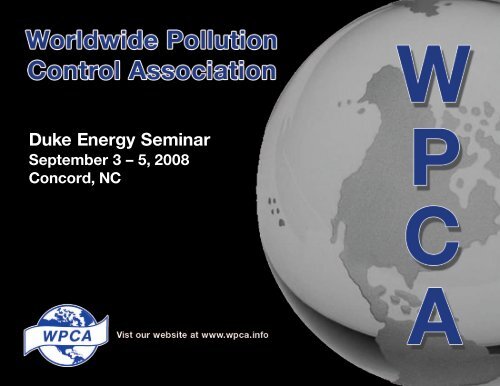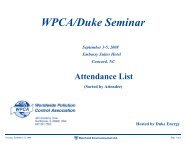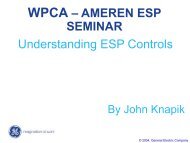Create successful ePaper yourself
Turn your PDF publications into a flip-book with our unique Google optimized e-Paper software.
Duke Energy SeminarSeptember 3 – 5, 2008Concord, NC
Wet FGD <strong>Chemistry</strong> andPerformance FactorsGordon Maller – URS CorporationPresented at:2008 WPCA Duke Energy SeminarSeptember 5, 2008
Presentation Outline• FGD <strong>Chemistry</strong> Overview• Effect of Key Process Variables onFGD Operation and Performance• Chemical Process Problems – HowTo Identify and Correct
What Are Chemical Reactions?• Two or more reactants (molecules) combining(reacting) to form different products• Reactants and products can be gas, liquid orsolid• Examples:− SO 2 (g) + H 2 O H 2 SO 3 (aq)− Ca ++ + SO=4 + 2H 2 O CaSO 4 *2H 2 O• The rate of a reaction depends on:− Nature and concentration of the reactants andproducts− Temperature
Types of SolutionsGas-Liquid(CO 2and Water)Solid-Liquid(Coffee and Sugar)Liquid-Liquid(Gin and Tonic)Solid Solution(A crystal whichcontains a mixtureof molecules fromtwo differentsolids)
SolubilityDefinition: Amount of substance required to produce saturated solution.The substance is the solute. The liquid substance it isdissolving into is the solvent.TemperatureEffects:SolubilitySugar or SaltTypicalGypsum CaSO 3LimestoneTemperature
Acids and BasesDefinition: Acid = pH < 7 Base = pH > 7Stomach AcidSulfurous AcidVinegarTypical <strong>Scrubber</strong>WaterLimestoneLimepH1 7 14Sulfuric AcidCoca ColaDBABloodDrainoLye
BuffersDefinition: Chemical species that can absorb aH + ion and moderate a pH change:CaCO 3 + 2H + Ca ++ + HCO 3-+ H + Ca ++ + H 2 CO 3
Overall <strong>Chemistry</strong> of a Limestone ForcedOxidation FGD SystemSulfurDioxideLime-+ + Oxygen + Water Gypsum +stoneCarbonDioxideSO 2+ CaCO 3 + O 2+ H 2O CaSO 4.2H 2O + CO 2Gas Solid Gas LiquidSolid GasReactions involve gas, liquid, and solid phases
Chemical Reaction Steps in FGDProcess• SO 2 absorption in absorber• Neutralization of the absorber SO 2 to keep theSO 2 vapor pressure low so that more SO 2 canbe absorbed• Dissolution of the limestone or lime reagent toprovide alkalinity for neutralization andcalcium ion for precipitation• Oxidation of absorbed SO 2 to form sulfate(SO 4 )• Precipitation of calcium and sulfate or sulfiteto form byproduct
Wet Limestone Forced Oxidized Process<strong>Chemistry</strong>SO 2 Absorption:SO 2 + H 2 O H 2 SO 3H 2 SO 3 H + + HSO 3Limestone Dissolution:CaCO 3 + H 2 O Ca ++ + HCO 3 + OH -Oxidation:HSO 3 + O 2 H + + SO=4Precipitation:Ca ++ + SO=4 + 2H 2 O CaSO 4 * 2H 2 O
Mass Transfer and Reaction Steps Occurat Several Places in FGD System• Absorber• Reaction tank• Solid-liquid separationWaterBoilerDustCollectorStackFuelAirAsh RemovalIDFanAirAbsorberSO2 Absorber BleedLimestoneHydrocycloneWashWaterConvertorGypsumBelt FilterGypsumDewateringWasteWaterReagentPreparationSiloBall Mill GrinderSlurry Storage Tank
Mass Transfer and Reaction Steps Occurat Several Places in FGD System (cont.)Absorber• SO 2 absorption• Reagent dissolution• CO 2 evolution or absorption• Sulfite oxidation• Solids precipitation• HCl and HF absorption
Mass Transfer and Reaction Steps Occurat Several Places in FGD System (cont.)Reaction Tank• Limestone dissolution• <strong>Scrubber</strong> solids precipitation• Sulfite oxidation
Mass Transfer and Reaction Steps Occurat Several Places in FGD System (cont.)Solids-Liquid Separation• Solids concentration− Gravity settling (e.g., thickener)− Hydroclones− Filtering− Centrifuging
Overview of Mass Transfer and ReactionSteps by PhaseGas-Liquid Mass TransferLiquid-Solid Mass TransferCarbon Dioxide DesorptionCarbonateCalciumMagnesiumSodiumCarbonateDissolutionLimestoneSulfur DioxideOxygenAbsorptionAbsorptionSulfiteSulfatePrecipitationCalcium SulfateHClAbsorptionH+ChlorideFluorideCarbonate + H + BicarbonateSulfite + H + BisulfiteGas Phase Liquid Phase Solid Phase
Acid-Base Equilibrium ReactionsSO 2(g)+ H 2O H 2SO 3H + + HSO 32H + + SO 3=SulfurousAcidpK 1.81 pK 6.91BisulfitepK 6.37 pK 10.25SulfiteCO 2(g)+ H 2O H 2CO 3H + + HCO 32H + + CO=3Carbonic Bicarbonate CarbonateAcidIncreasing pHDecreasing pH
Liquid-Phase Alkalinity• Concentration of liquid species that arealkaline with respect to SO 2 absorption• Main source of alkalinity for inhibitedoxidationFGD process
Liquid-Phase Alkalinity (cont.)Examples:Absorption SO 2 + H 2 O H + + HSO 3-GasNeutralization SO 3=+ H + HSO 3-CO=3 + H + HCO-3AqueousOverall CO 3=+ SO 2 + H 2 O HSO 3-+ HCO 3-Aqueous Gas
Solid-Phase Alkalinity• Dissolution of limestone in absorberreplenishes alkalinity and allows scrubbing tocontinue• Main source of alkalinity for forced-oxidationFGD process
Solid-Phase AlkalinityExamples:Absorption SO 2 + H 2 O H + + HSO 3GasDissolution CaCO 3 Ca ++ + CO 3=SolidH 2ONeutralization CO 3=+ H + HCO 3-AqueousOverall CaCO 3=+ SO 2 + H 2 O Ca ++ + HSO 3 + HCO 3-Solid Gas
Sulfite Oxidation Reactions(Free Radical Chain Reactions)SO 3=+ Fe +++ SO 3 * + Fe ++where SO 3 * is a free radicalSO 3 * . + 1 / 2 O 2 SO 4=Ca ++ + SO 4=+ 2H 2 O CaSO 4. 2H2 O (gypsum)
Sulfite OxidationDepends On:• Ratio of O 2 :SO 2• Solution chemistry− pH− [SO = 3 ]− Trace metals• Temperature
Solid-Liquid Equilibrium• Determines if limestone will dissolve• Determines if gypsum will precipitate• Dissolution refers to formation of ions insolution from a solid• Precipitation refers to formation of solids fromions in solution
What is Present in the Liquid Phase?Ions:Ca ++ , Na + , Mg ++ , SO 4= , Cl - , etc.Ion Pairs:CaCO 3 , CaHCO 3+ , MgHSO 3- , MgSO 3 , CaSO 4 , etc.All liquid phase reactions are at equilibrium:Ca ++ + CO=3 CaCO 3Ca ++ + HCO-3 CaHCO+3
Relative SaturationQ: Will limestone dissolve?R.S. =[Ca ++ ] . [CO 3= ]K sp[Ca ++ ] = Ca ++ Activity (Conc.)[CO 3= ] = CO 3=Activity (Conc.)K sp = CaCO 3 SolubilityproductconstantA: Yes – when R.S. is < 1 (subsaturated)No – when R.S. is > 1 (supersaturated)
Q: Will Gypsum (CaSO 4.2H 2 O)Precipitate?R.S. =[ Ca ++ ] . [SO 4= ] . [H 2 O] 2K spA: Yes – when R.S. is > 1No – when R.S. is < 1
Two Types of Gypsum Precipitation• Nucleation (spontaneous)• Crystal growth (controlled)Gypsum Precipitation Rate, r GSafeCrystal GrowthNucleationScaling1.3 – 1.4Gypsum Relative Saturation, RS G
Factors that Determine Type of GypsumPrecipitation• Relative saturation of the solution• The presence of sufficient amount of seedsolids• The rate at which the gypsum precipitates
Crystal Size, Shape, and Habit• Affect dewatering and handling properties ofsolids• Determined by:− FGD process or design− Type of crystal (gypsum or calcium sulfite)− Contaminants in the crystal− Crystal habit modifiers− Residence Time
Gypsum Crystal: Triclinic System(No Axis of Symmetry)
Calcium Sulfite Crystal: OrthorhombicSystem (Three, 2-Fold Axes ofSymmetry)
FGD Gypsum Solids From Different Processes**(Same Magnification)
Effect of Key ProcessVariables on FGD Operationand Performance
Performance Variables That RequireControl• SO 2 removal efficiency• Reagent utilization• Scaling potential
SO 2 Removal EfficiencyKey Chemical Factors• pH or alkalinity• Excess limestone in recycle slurry (key forforced oxidized process)• Solution chemistry• Inlet SO 2 loading (combination ofconcentration and load)
SO 2 Removal Efficiency (cont.)Key Mechanical Factors• Liquid-to-gas ratio (L/G)• Mass transfer characteristics of absorber (e.g.,trays, packing)• Gas / liquid distribution• Flue gas bypass (where applicable)
Reagent UtilizationKey Factors• pH• Solution chemistry• Solids residence time• Surface area (grind size)• Limestone reactivity
Causes of ScalingKey Factors• Oxidation (not usually a factor in forcedoxidation process)• Limestone utilization• Slurry density• Reaction tank volume• ME wash design or operation• ME wash water quality
Factors That Affect FGD Performanceand ReliabilityOperators have direct, limited or no control of key parameters• Direct Control− pH **− Slurry density**− L/G• Limited Control− Limestone properties**− Solution chemistry**− Mechanical factors− Water management• No Control− Boiler load cycles− Coal S variations− Inlet flue gas**To be discussed
pH / Utilization / SO 2 RemovalRelationshipsUtilizationSO 2 Removal(lower)pH(higher)
Slurry Density (Slurry SolidsConcentration)• Minimum slurry density ensures adequatecrystal surface area for precipitation. This isimportant to prevent scaling• Maintaining a higher slurry density canimprove limestone utilization• Slurry density affects solids residence timewhich, in turn, affects limestone utilization andscaling potential
Explanation of Effect of Slurry Densityon Limestone Utilization• Maintaining pH and SO 2 removal requires aspecific limestone loading (g-limestone/Lslurry)level for the system.• At low density (low concentration of solids inthe slurry), a higher concentration of thesolids will be limestone. Therefore limestoneutilization will be lower.
Solution <strong>Chemistry</strong>• Dissolved Cl - (Ca ++) Concentration− Inhibits dissolution due to common ion effect• Forced oxidation vs. natural oxidation− Stripping of CO 2 tends to enhance dissolution• Aluminum fluoride blinding• Sulfite blinding− Problem during periods of incomplete oxidation• All can affect the ease with which reagentdissolves and removal performance ofscrubber
Effect of Dissolved CalciumConcentration(Different Shaped Symbols Represent Different Limestone Tested)95Low Dissolved CaSO 2Removal (%)908580High Dissolved Ca750 5 10 15 20 25 30 35 40Limestone Loading (g/L)
Effect of Oxidation Mode(Different Shaped Symbols Represent Different Limestone Tested)95SO 2Removal (%)908580Forced Oxidation ModeNatural Oxidation Mode750 5 10 15 20 25 30 35 40Limestone Loading (g/L)
Effect of Soluble Aluminum onLimestone Utilization1009080Utilization (%)706050403020010 20 30 40Aluminum (mg/L)
Limestone Properties Affecting <strong>Scrubber</strong>PerformanceProperties will affect pH-Utilization-Removalrelationship• Grind• Composition• Reactivity (dolomitic fraction)
Effect of Limestone Grind(Different Shaped Symbols Represent Different Limestone Tested)9590SO 2Removal (%)858075Fine Ground Limestone (90% Pass 325 mesh)Course Ground Limestone (70% Pass 325 mesh)700 5 10 15 20 25 30 35 40Limestone Loading (g/L)
Effect of Limestone Dolomitic Fraction95SO 2Removal (%)908580Limestone With Low Dolomitic FractionLimestone With High Dolomitic Fraction7505 10 15 20 25Limestone Loading (g/L)
Chemical Process Problems –How To Identify and Correct
Problem Areas To Be Discussed• Scaling and solids buildup• Mist eliminator pluggage• Limestone blinding• Poor SO 2 removal• Poor reagent utilization• Poor gypsum byproductquality
Scaling and Solids BuildupCommon areas for scaling:• <strong>Scrubber</strong> inlet• Absorber internal walls andsupport structure• Absorber spray headers• Inside spray piping• Trays• Reaction tank walls
Causes of Scaling and Solids Buildup• Chemical (high gypsum relative saturation)−Oxidation−Insufficient seed solids−Solid residence time that is too short−Poor wash water quality• Wet-dry interface and recirculation of slurry• Poor reagent utilization
Causes of Scaling in FGD SystemsHigh Gypsum Relative Saturation:• Scaling can occur in all areas of absorber andon mist eliminator (ME) as result of solidsnucleation due to high relative saturation• High relative saturation usually result ofinsufficient seed material or high precipitationrates• Scaling in ME may result from poor qualitywash water (water saturated or nearlysaturated with gypsum)
Causes of Scaling in FGD SystemsWet/dry Interface:• Occurs in area of absorber where hot flue gasis quenched• Scaling results from fluctuations in gas flowand gas distribution. Causes areas along ductwalls or other internal structures to vary fromwet to dry• If slurry is carried back into this area, it maydry and accumulate as a hard scale composedof calcium sulfate, and/or fly ash
Causes of Scaling in FGD SystemsWet/dry Interface:• Scaling as result of a wet/dry interface iseliminated by:− Modifying the physical design of the absorber inletto eliminate the flow disturbance− Controlling the location of the wet/dry interface bymodifying the way flue gas is quenched
Scaling and Solids BuildupSteps to Correct:• Control process chemistry within designlimits• Ensure that inlet flue gas is quickly andcompletely quenched• Modify absorber inlet design to eliminateflow disturbances and gas recirculation• Maintain reagent utilization within designrange
Mist Eliminator Pluggage• Chemical causes−Poor reagent utilization−Poor quality wash water• Mechanical causes−Poor design of wash system−Broken or plugged wash system−High gas velocity−Non-uniform gas flow and liquid loading distribution
• IndicationMist Eliminator Pluggage−Increase in pressure drop−Visual observation during inspection• ME pluggage can:−Result in increased gas velocity throughME and liquid carryover into outlet ductand stack−Cause stack rainout and particulateemissions−Damage ME due to weight of solids
Considerations For ME Wash System• ME faces to wash• Wash coverage (150 to 200%)• Wash intensity and pressure (1.5 gpm/sqft, 30 to 45 psi)• Wash duration and frequency• Recommended wash nozzles
Inhibited Dissolution of Limestone• Limestone must dissolve in scrubber toprovide alkalinity• Certain dissolved chemical species cansignificantly slow or stop the dissolution oflimestone• Inhibition - Slowing of dissolution• Blinding - Significant slowing or stopping ofdissolution• High concentrations of dissolved chloride andmagnesium will inhibit dissolution• The mechanism for this inhibition is called“common-ion” effect
Limestone Blinding• In forced oxidation process, limestoneblinding can result from high concentrationsof dissolved sulfite or aluminum-fluoridecomplex• Either sulfite or aluminum-fluoride complexwill react on surface of limestone particle toblock dissolving site• Aluminum-fluoride blinding often initiated byhigh concentration of inlet fly ash• Sulfite blinding initiated by incompleteoxidation
Poor SO 2 Removal as Result of ChemicalProblemCauseInsufficient Limestone In<strong>Scrubber</strong>AnalyticalIndicationLow carbonate measured inscrubber solidsCorrective ActionIncrease pH set-pointMalfunctioning pH MonitorPoor agreement during pHcalibration checkMake repairs to pH monitorsystemSulfite BlindingPoor reagent utilizationalong with elevated levelsof soluble sulfiteAluminum Fluoride Blinding Poor reagent utilizationalong with elevated levelsof aluminum and fluorideVerify operation of oxidationair system. Correct asrequiredImprove particulate removalupstream of scrubberPoor Limestone Quality orOff-Spec Grind SizeSieve analysis, compositionanalysisModify grind circuit and/orobtain better limestone
Poor SO 2 Removal as Result ofMechanical ProblemCause Indication Corrective ActionPlugged Spray Header(s)or Spray Nozzle(s)Broken Spray HeaderLoss of Recycle PumpCapacityLow recycle flow Asindicated by flow meter ormotor ampsIndication from flow meteror motor amps. Observedduring inspectionLow recycle flow asindicated by flow meter ormotor ampsClean during outageRepair during outageRepair during outage
Poor Reagent UtilizationCauseMalfunctioning pH MonitorAnalyticalIndicationPoor agreement during pHcalibration checkCorrective ActionMake repairs to pH monitorsystemSulfite BlindingPoor reagent utilizationalong with elevated levelsof soluble sulfiteAluminum Fluoride Blinding Poor reagent utilizationalong with elevated levelsof aluminum and fluorideVerify operation of oxidationair system. Correct asrequiredImprove particulate removalupstream of scrubberPoor Limestone Quality orOff-Spec Grind SizeSieve analysis, compositionanalysisModify grind circuit and/orobtain better limestone
Poor Gypsum Byproduct Quality• High acid insoluble (inerts) fraction− Verify operation of particulate control device upstream ofscrubber− Optimize operation of process hydroclones to maximizeconcentration of inerts in overflow− Increase liquid purge rate• Poor reagent utilization• Low sulfite oxidation− Verify operation of oxidation air system
Poor Gypsum Byproduct Quality (cont.)• High moisture− Verify operation of primary and secondary dewateringsystem− Purge fines from process− Check filter cloth for blinding. Clean or replace asrequired− Increase temperature of filtercake wash water− Verify system chemistry• High level of limestone• High level of acid insolubles• Presence of crystal modifier
















